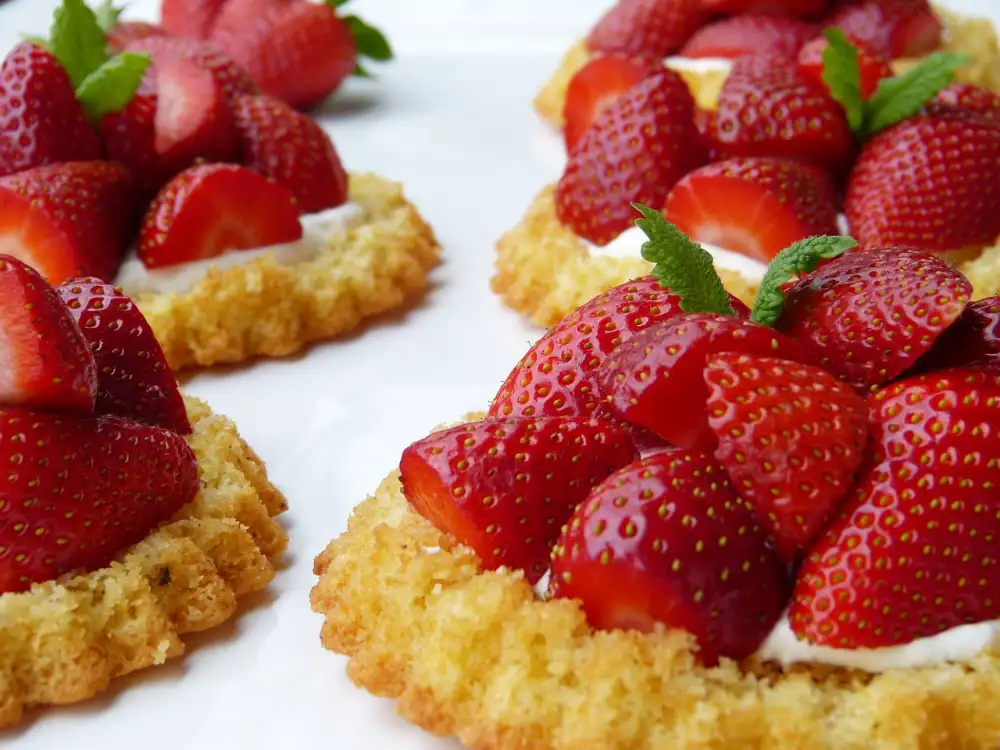Unlocking the Secrets of Gluten-Free Flour: Your Guide to Healthy Baking

Gluten-free flour has gained popularity in recent years as more people are adopting a gluten-free lifestyle. But what exactly is gluten-free flour? Simply put, it is a type of flour that does not contain the protein known as gluten. Gluten is found in grains such as wheat, barley, and rye, and can cause adverse reactions in individuals with celiac disease or gluten sensitivity. By using gluten-free flour, individuals can still enjoy their favorite baked goods without compromising their health. In this article, we will explore the benefits of using gluten-free flour and provide tips for baking with it. So let's dive in and unlock the secrets of gluten-free flour!
Understanding gluten and its effects on health
Understanding gluten and its effects on health is crucial when considering a gluten-free lifestyle. Gluten is a protein found in wheat, barley, and rye. For individuals with celiac disease or gluten sensitivity, consuming gluten can lead to various health issues. Celiac disease is an autoimmune disorder that damages the small intestine, causing digestive problems and nutrient deficiencies. Gluten sensitivity can cause similar symptoms but without the intestinal damage. By eliminating gluten from their diet, individuals can alleviate these symptoms and improve their overall health. It's important to note that not everyone needs to avoid gluten, but for those who do, understanding its effects is essential.
Benefits of using gluten-free flour
Using gluten-free flour in your baking can bring about numerous benefits for your health. Firstly, it allows individuals with gluten sensitivities or celiac disease to enjoy baked goods without experiencing any adverse reactions. This is especially important as gluten can cause inflammation in the gut and lead to digestive issues.
Furthermore, gluten-free flour is often made from alternative grains and starches that are rich in nutrients. These include quinoa, brown rice, almond flour, and tapioca starch. By incorporating these ingredients into your diet, you can increase your intake of fiber, protein, vitamins, and minerals.
Another advantage of using gluten-free flour is that it can help maintain stable blood sugar levels. Traditional wheat flour tends to be high on the glycemic index, causing a rapid spike in blood sugar levels. In contrast, gluten-free flours have a lower glycemic index, resulting in a more gradual release of glucose into the bloodstream.
Moreover, many people find that using gluten-free flour enhances the taste and texture of their baked goods. It can add a unique nutty flavor or create a lighter and fluffier texture compared to traditional wheat-based products.
Lastly, by opting for gluten-free flour, you open up a world of culinary possibilities. You can experiment with different types of flours to create diverse recipes such as pancakes, cakes, breads, and pastries that cater to various dietary needs.
In conclusion, the benefits of using gluten-free flour extend beyond just catering to those with specific dietary requirements. It promotes better digestive health while providing essential nutrients and offering a wider range of flavors and textures in your baking endeavors.
Types of gluten-free flour available in the market
When it comes to gluten-free baking, there are a variety of flour options available in the market. These alternatives provide a great solution for those with gluten sensitivities or celiac disease. Some popular types of gluten-free flour include almond flour, coconut flour, rice flour, tapioca flour, and sorghum flour. Each of these flours has its own unique characteristics and flavors, allowing for versatility in baking. Experimenting with different combinations of these flours can help achieve the desired texture and taste in gluten-free baked goods. It's important to note that not all gluten-free flours are created equal, so it's essential to read labels and choose high-quality brands for optimal results.
Nutritional value of gluten-free flour
Gluten-free flour offers a range of nutritional benefits that make it a valuable addition to any diet. While traditional wheat flour contains gluten, which can be difficult for some individuals to digest, gluten-free flours are typically made from alternative grains and starches such as rice, corn, potato, or tapioca. These ingredients provide essential nutrients like fiber, vitamins, and minerals. Additionally, many gluten-free flours are fortified with iron and B-vitamins to compensate for the nutrients lost during processing. This makes gluten-free flour a nutritious choice for those with celiac disease or gluten sensitivity, as well as anyone looking to improve their overall health through a balanced diet.
Tips for baking with gluten-free flour
When it comes to baking with gluten-free flour, there are a few tips that can help ensure success. Firstly, it's important to remember that gluten-free flours have different textures and absorbency levels compared to traditional wheat flour. Therefore, it's recommended to use a blend of gluten-free flours to achieve the desired texture and taste.
Additionally, adding xanthan gum or guar gum to your recipes can help improve the elasticity and binding properties of gluten-free flour. These gums act as a substitute for gluten in providing structure and preventing crumbling.
Another tip is to increase the liquid content in your recipes when using gluten-free flour. This helps compensate for the dryness often associated with these flours. You may need to experiment with the amount of liquid until you achieve the desired consistency.
Furthermore, it's advisable to sift gluten-free flour before using it in your recipes. This helps break up any clumps and ensures even distribution throughout your batter or dough.
Lastly, be mindful of baking time and temperature adjustments when using gluten-free flour. Due to its different composition, baked goods made with gluten-free flour may require slightly longer baking times or lower temperatures than traditional recipes.
By following these tips, you can overcome some of the challenges associated with baking with gluten-free flour and create delicious treats that everyone can enjoy.
Substituting gluten-free flour in recipes
Substituting gluten-free flour in recipes can be a bit tricky, but with the right knowledge, you can still enjoy your favorite baked goods. The key is to find the right type of gluten-free flour that will work best for your recipe. Some popular options include almond flour, coconut flour, and rice flour.
When substituting gluten-free flour for regular flour, it's important to keep in mind that gluten-free flours tend to absorb more liquid. This means you may need to adjust the amount of liquid in your recipe or add additional moisture to prevent dryness.
Another tip is to use a blend of different gluten-free flours to achieve a better texture and taste. Mixing different flours can help mimic the elasticity and structure that gluten provides.
Additionally, adding xanthan gum or guar gum to your recipe can help improve the texture and binding properties of gluten-free flours. These gums act as thickeners and emulsifiers, helping to create a more cohesive dough or batter.
It's also worth noting that some recipes may require additional ingredients such as eggs or baking powder to help with leavening and structure when using gluten-free flour.
Experimentation is key when substituting gluten-free flour in recipes. It may take some trial and error before you find the perfect combination of ingredients and techniques that work for you. Don't be discouraged if your first attempts don't turn out as expected – practice makes perfect!
By being open-minded and willing to adapt your favorite recipes, you can still enjoy delicious baked goods while embracing a gluten-free lifestyle. So go ahead, get creative in the kitchen and unlock the secrets of gluten-free baking!
Common misconceptions about gluten-free flour
There are several common misconceptions surrounding gluten-free flour that need to be addressed. One of the most prevalent misconceptions is that gluten-free flour is tasteless and produces dry, crumbly baked goods. While it is true that gluten-free flours have a different texture and taste compared to traditional wheat flour, this does not mean they cannot create delicious and moist baked goods. With the right combination of ingredients and techniques, gluten-free baking can yield equally satisfying results.
Another misconception is that gluten-free flour is only suitable for those with celiac disease or gluten intolerance. While it is true that individuals with these conditions must avoid gluten, anyone can benefit from incorporating gluten-free flour into their diet. Gluten-free flours are often made from nutrient-rich alternatives such as rice, almond, or quinoa, which can provide additional vitamins and minerals compared to traditional wheat flour.
Some people also believe that using gluten-free flour automatically makes a recipe healthier. While it is true that eliminating gluten can have health benefits for those with specific conditions, simply substituting regular flour with a gluten-free alternative does not automatically make a recipe healthier. It's important to consider the overall nutritional content of the ingredients used in the recipe.
Lastly, there is a misconception that baking with gluten-free flour requires complex and expensive ingredients. While some specialty ingredients may be used in certain recipes, many basic recipes can be made using simple and affordable ingredients found in most pantries. Experimenting with different combinations of flours and starches can also help achieve desired results without breaking the bank.
It's important to debunk these misconceptions about gluten-free flour so that more people can embrace its benefits without hesitation. By understanding the truth behind these myths, individuals can confidently explore the world of gluten-free baking and enjoy delicious treats while maintaining their health goals.
In conclusion, embracing a gluten-free lifestyle can have numerous benefits for your health. By eliminating gluten from your diet and using gluten-free flour in your baking, you can reduce inflammation, improve digestion, and increase energy levels. Gluten-free flour options are widely available in the market, offering a variety of choices to suit different dietary needs and preferences. With proper knowledge and techniques, you can successfully bake delicious and nutritious gluten-free treats. Don't let misconceptions hold you back - give gluten-free flour a try and unlock the secrets to healthy baking today!
Published: 16. 12. 2023
Category: Health



